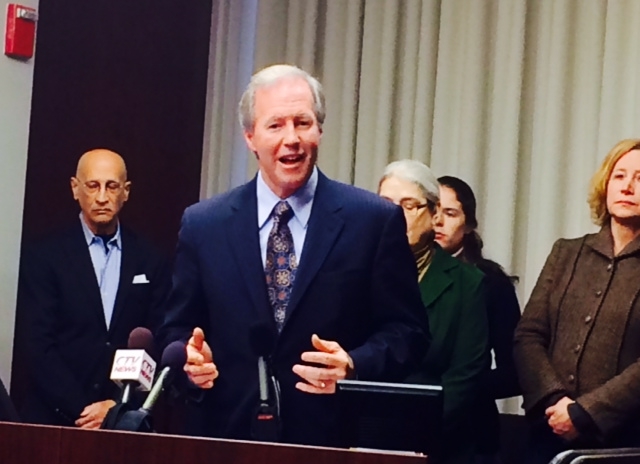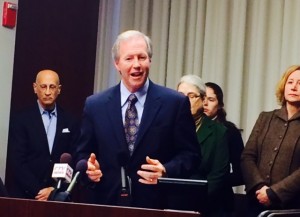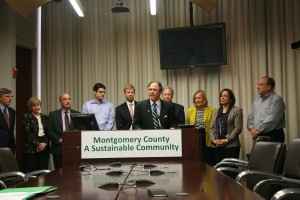
Council Committees to Discuss Environmental, Campaign Finance Bills
 The Montgomery County Council’s Government Operations and Fiscal Policy (GO) Committee will hold a worksession at 2 p.m. on March 17 on proposed Bill 16-14 that would establish a system of public campaign financing for candidates for the offices of County Executive and County Council.
The Montgomery County Council’s Government Operations and Fiscal Policy (GO) Committee will hold a worksession at 2 p.m. on March 17 on proposed Bill 16-14 that would establish a system of public campaign financing for candidates for the offices of County Executive and County Council.
The GO Committee, which is chaired by Nancy Navarro and includes Councilmembers Cherri Branson and Hans Riemer, will meet in the Third Floor Conference Room of the Council Office Building at 100 Maryland Ave. in Rockville. The meeting will be televised live by County Cable Montgomery (CCM—Cable Channel 6 on Comcast and RCN, Channel 30 on Verizon).
The chief sponsor of Bill 16-14 is Phil Andrews. The other eight Councilmembers have agreed to be co-sponsors.
Since 2001, members of the Montgomery County Council have urged the Maryland General Assembly to provide the County with the authority to adopt campaign finance reforms. In 2013, the General Assembly adopted a bill that enables counties to provide for the option of public financing for county elections beginning with the 2015-18 election cycle. Participation by candidates would be voluntary.
The bill would establish a Public Election Fund. To qualify for public financing, a candidate would have to:
· File a Notice of Intent prior to collecting qualifying money
· Establish a publicly funded campaign account
· Limit qualifying contributions to a maximum of $150 from registered voters in Montgomery County
· Collect a qualifying number of contributions: 500 for County Executive candidates; 250 for Council at-large candidates; and 125 for Council district candidates
· Collect qualifying dollar thresholds of $40,000 for County Executive; $20,000 for Council at-large; and $10,000 for Council district
· Adhere to the qualifying timing, beginning 365 days before the primary election and ending 45 days before the primary election
The plan provides strong incentives for candidates to seek out many small, individual donors. Matching dollars for County Executive candidates would be $6 for each dollar of a qualifying contribution received for the first $50; $4 for each dollar for the second $50; and $2 for each dollar for the third $50. Matching dollars for County Council candidates would be $4 for each dollar for the first $50; $3 for each dollar for the second $50; and $2 for each dollar for the third $50.
The maximum limit on public funds per candidate would be $750,000 for a County Executive candidate; $250,000 for a Council at-Large candidate and $125,000 for a Council district candidate. Matching dollars would not be distributed for self/spouse contributions.
ENVIRONMENTAL BILLS
 At 9:30 a.m. in the Third Floor Conference Room, the Transportation, Infrastructure, Energy and Environment (T and E) Committee, which is chaired by Roger Berliner and includes Councilmembers Riemer and Nancy Floreen, will hold worksessions on three bills that are part of a package of 13 measures introduced by Councilmember Berliner to address climate change.
At 9:30 a.m. in the Third Floor Conference Room, the Transportation, Infrastructure, Energy and Environment (T and E) Committee, which is chaired by Roger Berliner and includes Councilmembers Riemer and Nancy Floreen, will hold worksessions on three bills that are part of a package of 13 measures introduced by Councilmember Berliner to address climate change.
Bill 2-14 would require the owners of certain buildings to benchmark the energy use of the buildings and retro-commission the building systems to improve their energy efficiency. Modeled after laws in New York, Chicago and the District of Columbia, Bill 2-14 would require building owners to measure the energy efficiency of their buildings, make that information public and periodically commit to assuring that their energy efficiency equipment is working properly.
Bill 8-14 would require new or extensively remodeled County buildings to generate at least one kilowatt of renewable energy for every 1,000 square feet of floor area. Current County law does not set specific standards for the use of renewable technology in County buildings.
Bill 5-14 would require the Office of Management and Budget to submit an analysis of the social cost of carbon with certain capital projects in the Capital Improvements Program. The bill emphasizes that the use of conventional fuels, particularly coal, extracts a cost on society that is not reflected in its price. These “external” costs should be factored into the cost-benefit calculations that the County uses when it assesses the potential for energy efficiency improvements.

Engage us on Facebook
Follow us on Twitter
Tweets by @mymcmedia